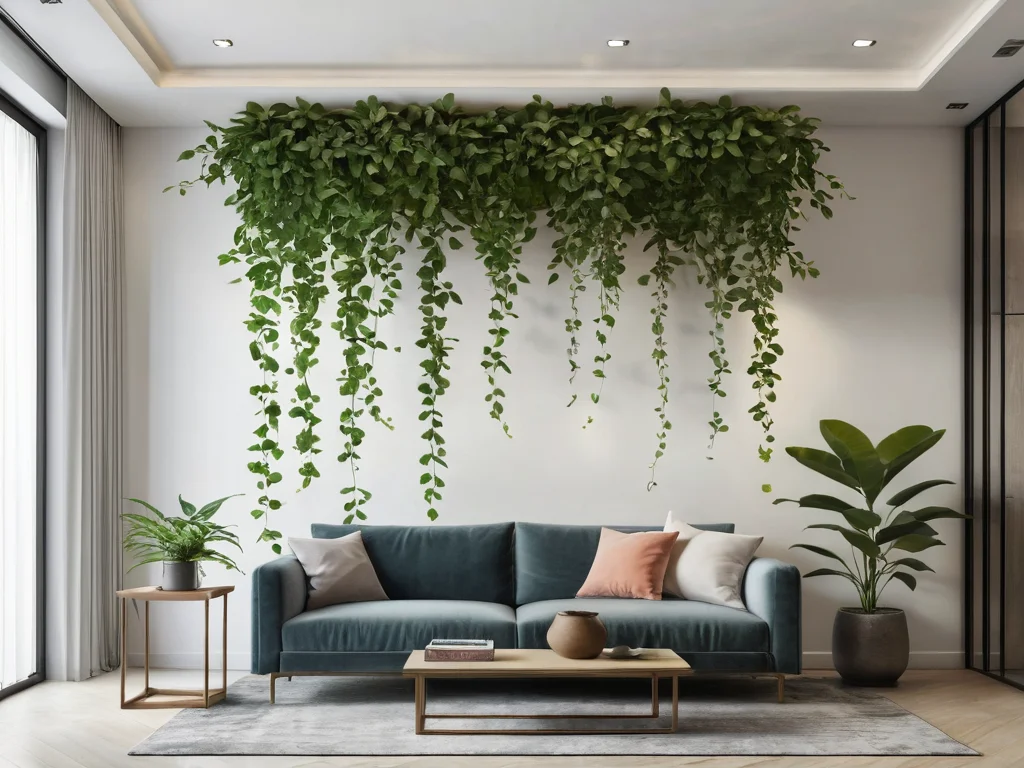Greetings, dear readers of fengshuihome.ru, a portal dedicated to the art of harmony and well-being! Today, we will delve into the amazing world of climbing plants – these green athletes capable of transforming any space. Their graceful curves and rapid growth can be a source of powerful positive energy for your home, or a cause of energetic stagnation if you don’t know how to work with them correctly. In Feng Shui, every element of the interior has its meaning, and climbing plants are no exception. They possess a unique ability to direct and transform the flows of Qi energy, making your home a true fortress of harmony and prosperity.
Introduction: Climbing Plants – A Gift or a Challenge for Your Home According to Feng Shui?
Climbing plants, or vines as they are also called, have always evoked mixed feelings in people. On one hand, they impress with their vitality, their ability to quickly fill space, creating a sense of lushness and the abundance of nature. On the other hand, their sometimes untamed, chaotic growth can be a source of anxiety, creating a feeling of disorder and confusion. In the context of Feng Shui, this duality is particularly pronounced. Climbing plants are believed to carry the strong energy of the Wood element, which symbolizes growth, development, vitality, and flexibility. However, like any powerful energy, it requires skillful management.
The positive influence of climbing plants on the home’s energy lies in their ability to soften sharp corners, mask undesirable structures, and create a sense of coziness and security. They can act as natural filters, purifying the air and filling the space with freshness. Feng Shui masters claim that properly placed and well-cared-for vines can attract good luck into the home, promote financial well-being, and improve relationships among household members.
However, thoughtless placement or lack of proper care for climbing plants can lead to the opposite effect. Their disordered growth, trailing vines, and dried leaves can generate negative Sha Qi energy, creating obstacles on the path to success, causing feelings of fatigue, irritation, and even leading to financial losses. This is precisely why it is so important to understand Feng Shui principles when working with these unique flora representatives, to transform them from a potential challenge into a true gift for your home.
Our task today is to learn this art, to understand how to direct the living energy of climbing plants for good, how to choose the right species, and where to best place them so that your home becomes a truly harmonious and prosperous corner.
The Energy of Vines: How Climbing Plants Affect Qi Flows in Space
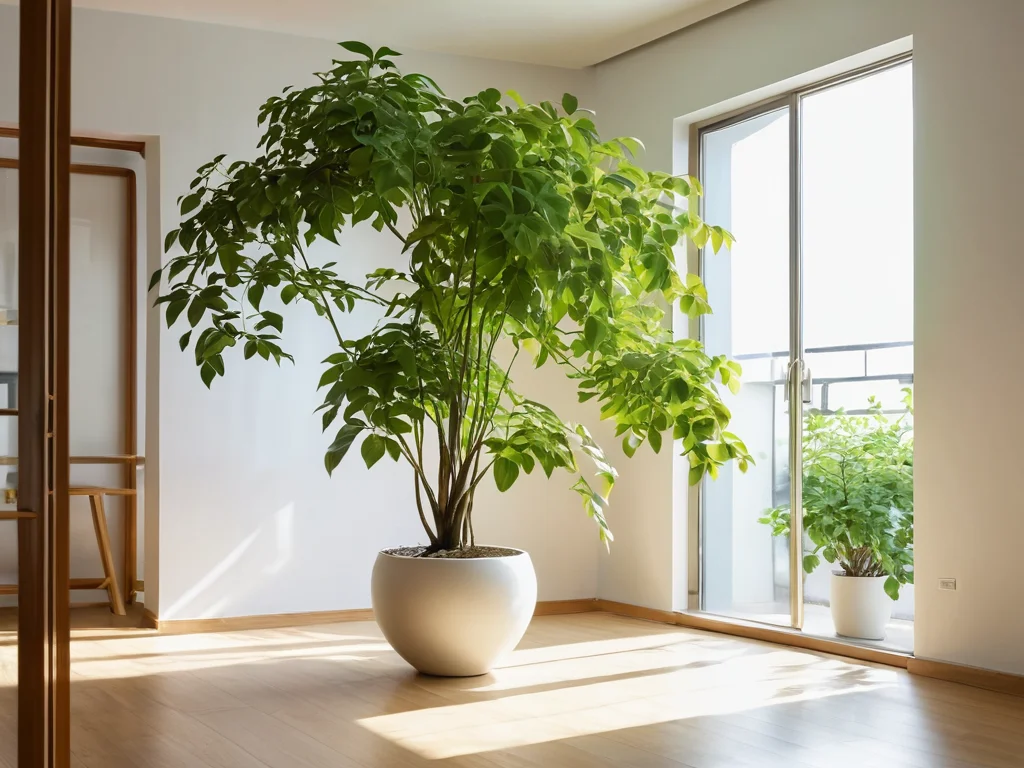
At the core of Feng Shui lies the concept of Qi – the universal life force that permeates all existence and circulates in space. The harmonious movement of Qi is the key to health, luck, and well-being. Climbing plants, due to their unique growth form and vitality, have a significant impact on these flows, and their effect can be both constructive and destructive, depending on how they are used.
Softening and Protection from Sha Qi: One of the most valuable qualities of climbing plants from a Feng Shui perspective is their ability to soften sharp corners and harsh lines, which are sources of Sha Qi (negative, aggressive energy). Sharp furniture corners, protruding beams, open shelves – all of these create “secret arrows” that direct Sha Qi directly at the inhabitants. Placing a climbing plant in such a way that its vines wrap around or cover these sharp forms helps neutralize the negative impact, transforming aggressive energy into soft and flowing Sheng Qi (positive, life-giving energy). Imagine the vine as a natural shield that envelops and softens all undesirable energetic impulses.
Directing and Activating Qi: Climbing plants, especially those that grow upwards, symbolize growth, development, and the pursuit of progress. Their vines, like natural conductors, can direct the flow of Qi to the desired areas of space, activating them. For example, if you have an empty corner that seems lifeless, a climbing vine growing upwards on a support can “lift” the energy in that area, making it more vibrant and dynamic. It is believed that this promotes the activation of wealth, career, or family sectors, depending on the plant’s placement.
Wood Element Energy: Climbing plants belong to the Wood element, which symbolizes growth, vitality, flexibility, creativity, and new beginnings. The presence of this element in the interior promotes the influx of fresh energy, renewal, and development. However, it is important to remember balance. An excess of the Wood element can cause excessive activity, nervousness, and even conflicts, especially if the plants look unkempt or chaotic.
Potential Risks: Uncontrolled growth of climbing plants can lead to Qi stagnation or the creation of so-called “enveloping” Sha Qi. If the vines hang too low, create a sense of entanglement, disorder, or press down from above, it can lead to energy oppression, a feeling of being blocked, and obstacles in affairs. This is especially true for plants whose vines hang over doorways, windows, or desks. This can symbolize “suffocating” energy that hinders clear thinking, blocks opportunities, or creates a feeling of heaviness.
Thus, climbing plants are not just decor, but a powerful tool for working with the home’s energy. By understanding their impact on Qi flows, you can consciously use their potential to create a harmonious and prosperous space.
Where to Let Vines Flourish? The Best Feng Shui Zones for Attracting Luck and Well-being
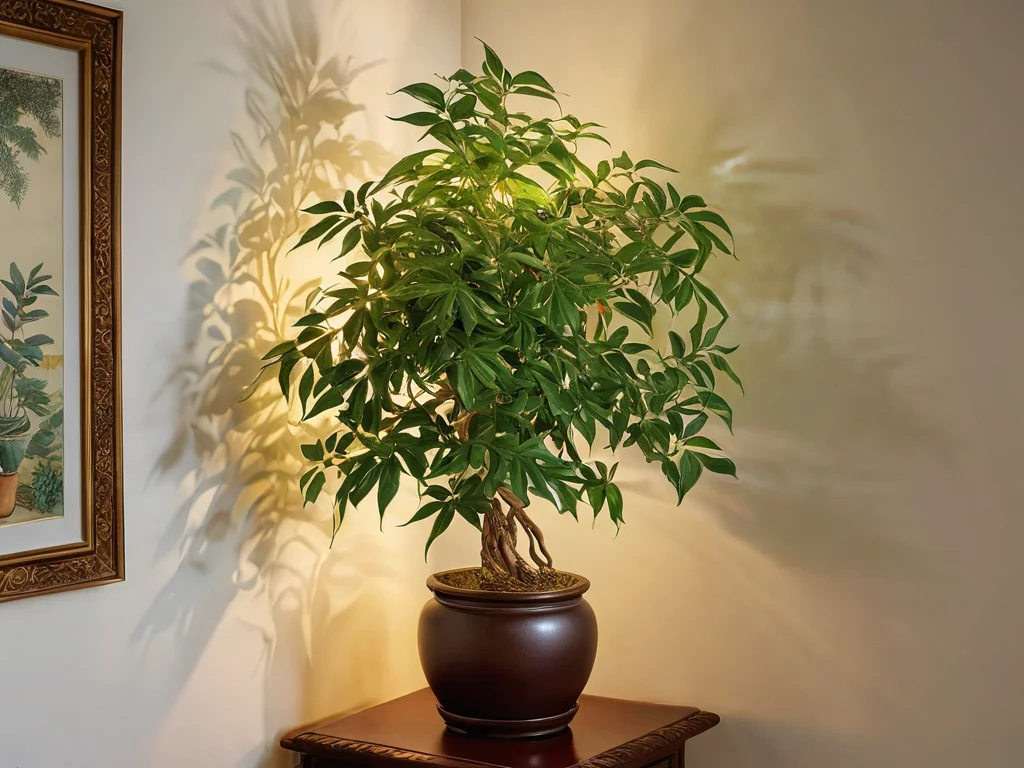
The choice of location for climbing plants in the home is a key moment in Feng Shui, determining whether they will bring you well-being or become a source of problems. Feng Shui masters recommend using the Bagua map as a guide, as well as considering general principles of Qi movement. Let’s explore which zones will be most favorable for your green companions.
- Southeast (Wealth Sector): This is one of the most favorable zones for placing climbing plants, especially those that symbolize prosperity, such as Pothos (money tree). The Wood element energy that vines possess naturally enhances the Wood element in the southeast sector, which promotes the attraction of financial well-being, income growth, and expansion of opportunities. Place the plant so that its vines gracefully curl upwards, symbolizing the continuous growth of your wealth. A healthy, lush plant in this sector is considered a powerful magnet for money.
- East (Family and Health Sector): The eastern sector also belongs to the Wood element, making it ideal for climbing plants. Here, they will contribute to strengthening family bonds, harmonizing relationships, and maintaining the health of all household members. Choose plants with soft, rounded leaves that symbolize smoothness and tranquility. Lush greenery in this sector is believed to help create an atmosphere of mutual understanding and support within the family.
- South (Fame and Reputation Sector): The southern sector is governed by the Fire element. Although Wood generates Fire, its presence here can be beneficial for enhancing your reputation, recognition, and achievement of goals. Choose plants that have a pronounced upward growth, symbolizing ascent and success. Ensure the plant looks energetic and healthy so that it reflects your bright image and achievements. However, be careful that the plant does not appear too aggressive or chaotic, which could have the opposite effect.
- Entrance Hall and Entry Zones: Climbing plants placed near the entrance, but not blocking it, can serve as an “invitation” for positive Qi, gently directing it into your home. They create a sense of hospitality and coziness. It is important that the plant does not block the passage or hang overhead, creating a feeling of pressure. Place it on a shelf or in a hanging basket so that its vines gently cascade but do not impede movement.
- Corners and Protruding Elements: As mentioned earlier, climbing plants are an ideal means to soften sharp corners, beams, and other sources of Sha Qi. Their flexible vines can literally wrap around these undesirable forms, transforming negative energy into positive energy. This is especially relevant for corners directed at a resting place or workspace.
- High Shelves and Upper Levels: By placing climbing plants on high shelves or cabinets, you encourage their upward growth, which symbolizes the pursuit of development, career advancement, and new achievements. The main thing is to provide them with sufficient light and care so that they do not look withered and neglected.
Remember that the key is balance and care. Even in the most favorable zone, a sick or unkempt plant will be a source of negative energy. May your vines always be lush, green, and directed upwards, symbolizing endless growth and prosperity.
From Selection to Placement: Which Climbing Plants Bring Harmony, and Which Don’t
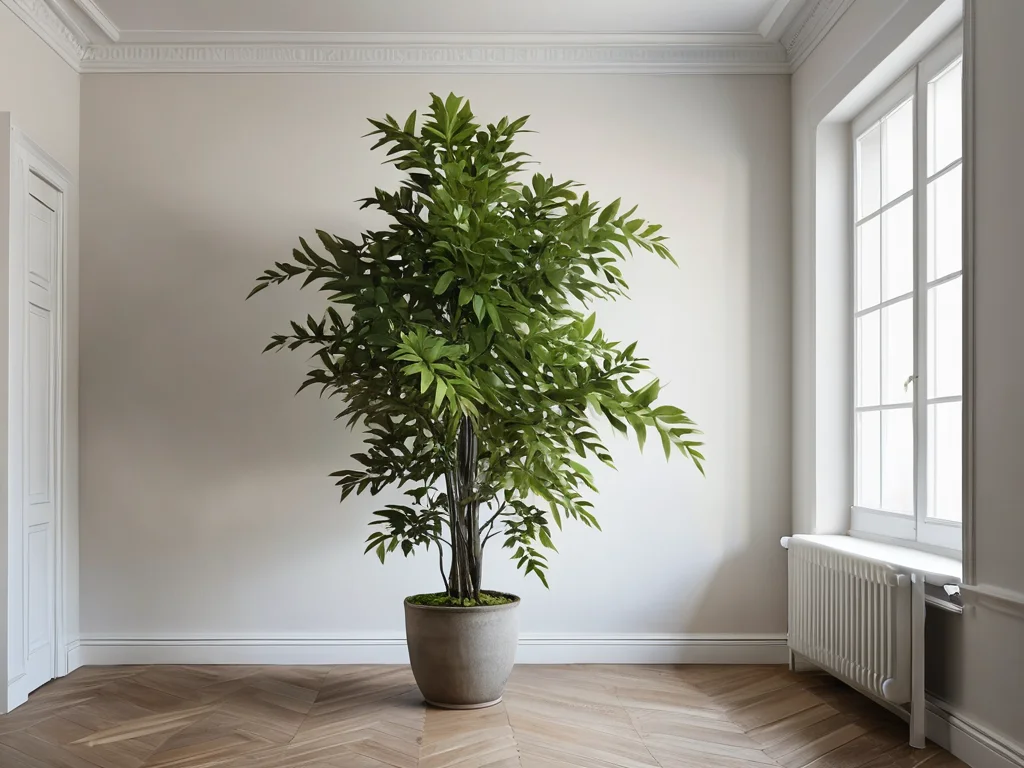
Choosing the right climbing plant for your home according to Feng Shui is more than just an aesthetic preference. Each species has its unique energy, which can either enhance harmony in your space or, conversely, create imbalance. Feng Shui masters recommend paying attention to the shape of the leaves, the direction of growth, and the overall condition of the plant.
Favorable Climbing Plants and Their Properties:
- Pothos (Epipremnum, “Money Tree”): One of the most popular plants in Feng Shui. It is believed that its round, shiny leaves attract wealth and prosperity. It possesses powerful purifying energy and can neutralize the negative impact of electromagnetic radiation from household appliances. Its unpretentiousness and rapid growth symbolize constant forward movement. Ideal for the Wealth sector (Southeast) and office spaces.
- Philodendron: There are many species of philodendrons, many of which are climbing. Their leaves often have a heart shape, symbolizing love and harmony in relationships. Philodendrons are known for their air-purifying properties and their ability to create an atmosphere of calm and protection. They are recommended for placement in areas where strengthening family ties (East) or creating a cozy, protected atmosphere in the living room is desired.
- Hoya (Wax Plant): This plant has dense, waxy leaves and fragrant flowers. In Feng Shui, Hoya is associated with attracting positive energy, love, and well-being. It is considered a plant that promotes the strengthening of romantic relationships and the creation of a sweet, pleasant atmosphere. The delicate flowers of Hoya can add an element of sophistication and grace. Suitable for relationship sectors (Southwest) and living rooms.
- Cissus (Grape Ivy): This plant has elegant, delicate vines that are easily shaped. Cissus symbolizes flexibility, adaptability, and the ability to overcome difficulties. It helps create a sense of freshness and vitality. It can be used to soften corners or create a green screen in any living space, except the bedroom.
Plants Requiring Caution or Undesirable:
- Plants with sharp leaves or thorns: Although many climbing plants have soft leaves, it is important to avoid any plants with thorns, prickles, or very sharp, pointed leaves (e.g., some cacti that can be climbing). They generate Sha Qi, creating a sense of aggression, tension, and conflict. Their presence in the home, especially in relaxation areas, can negatively affect health and relationships.
- English Ivy (Hedera helix): This plant is controversial among Feng Shui masters. On one hand, it can beautifully cover walls and buildings from the outside, protecting them and softening hard lines. On the other hand, it is believed that inside the house, ivy can “drain” energy, especially in the bedroom, and even contribute to quarrels. If you still decide to use ivy, make sure it looks healthy, its growth is directed upwards, and it is not placed in the bedroom or other critical areas.
- Plants that grow too quickly and aggressively: Some vine species grow very quickly and can look unmanageable. Although rapid growth can symbolize activity, excessive aggressiveness of the plant without proper control can create a sense of chaos, overwhelm, and absorption. It is important to regularly prune such plants so that their growth is orderly and harmonious, symbolizing controlled, purposeful progress.
General Selection Rules:
When choosing any climbing plant, always pay attention to its overall condition. It should be healthy, lush, without yellowed or wilting leaves. Choose plants with rounded or heart-shaped leaves, as they radiate softer and more favorable energy. Remember that a plant is a living being, and your attitude towards it also affects its energy and, consequently, the energy of your home.
The Art of Direction: Shaping the Growth of Climbing Plants to Enhance Positive Qi
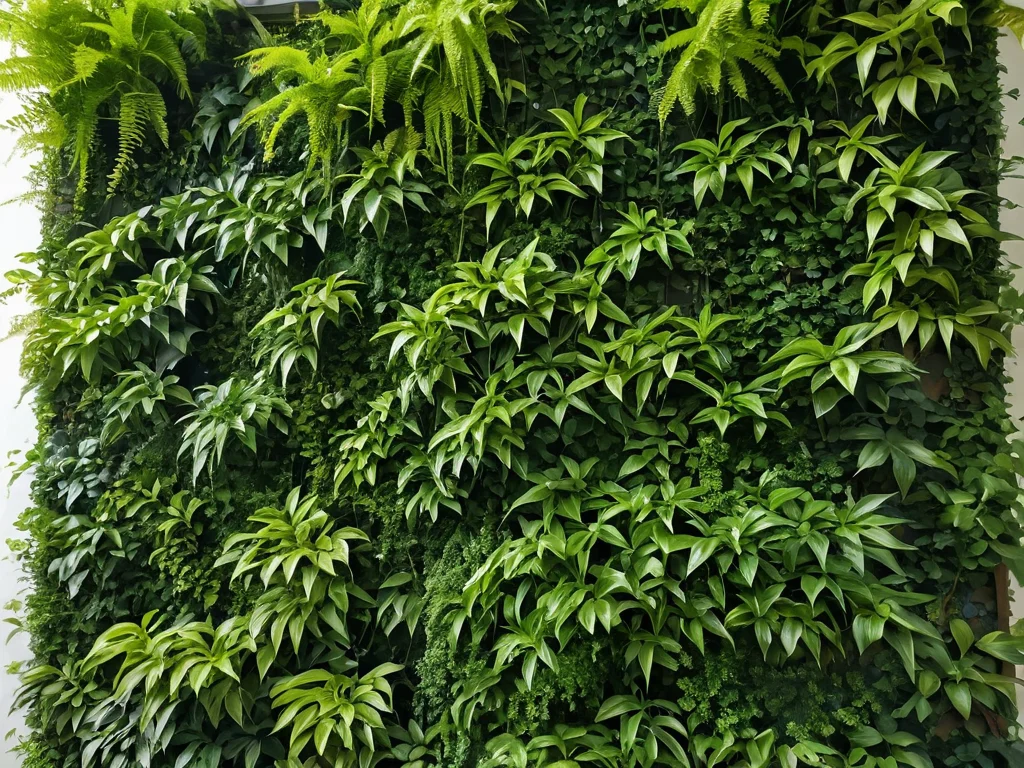
As a Feng Shui Master, I often say that climbing plants are not just living decor; they are brushes in the hands of an artist capable of creating energetic masterpieces. A climbing plant in itself possesses immense vitality, but it is you, by directing its growth, who transforms this force into a flow of positive Qi. This is the true art of direction.
Why is the direction of growth so important?
- Symbolism of upward striving: In Feng Shui, upward growth is associated with progress, development, career advancement, goal achievement, and spiritual growth. When you direct the vines upwards along a support, you activate this energy of striving and growth in your home and your life. It is believed that this helps overcome obstacles and reach new heights.
- Creation of Sheng Qi: The smooth, spiral, or ascending lines created by climbing plants promote the harmonious movement of Sheng Qi. This energy brings well-being, health, and joy. Chaotically hanging or tangled vines, on the contrary, can create Sha Qi, bringing stagnation and problems.
- Transformation of negative zones: By directing the plant to wrap around or cover sharp corners, open beams, or unaesthetic interior elements, you actively transform Sha Qi into Sheng Qi. The plant becomes a living tool for harmonizing the space.
Practical Tips for Shaping Growth:
- Use supports: This is the most important tool. Moss poles, decorative trellises, bamboo stakes, special supports, or even strong threads – all of these will help your plant grow upwards. Attach the vines to the support as they grow, gently guiding them.
- Direct towards light and upwards: The plant’s natural tendency to seek light is already a good indicator. Place the support in such a way that the plant can reach for the light source, simultaneously directing its growth upwards or along the wall.
- Form rounded or ascending shapes: Avoid straight, sharp lines when directing growth. Prefer smooth curves, spirals, or vertical ascent. If you are using the plant to cover a corner, let it gently wrap around it without creating rigid boundaries.
- Regular pruning: Pruning is not just a matter of aesthetics but a crucial aspect of Feng Shui. It allows for the removal of withered or dry parts, which are sources of dead Qi, and also stimulates healthy, controlled growth. Prune vines that start to hang too low, get tangled, or grow chaotically. This symbolizes that you are in control of your life and directing it in the right direction.
- Avoid hanging vines over doorways and work areas: If the plant is growing in a hanging basket, ensure its vines do not hang over doorways, corridors, beds, or desks. This creates “pressure from above,” symbolizing obstacles, difficulties in decision-making, and blocking new opportunities. The flow of Qi will slow down, and people will feel oppressed or even aggressive. If the vines are too long, direct them along the wall or prune them.
- Create “green walls” or “living curtains”: If you want to use a climbing plant for zoning or creating a secluded corner, direct its growth along a thin lattice or vertical support. This will create a gentle but effective barrier that allows Qi to pass through while providing a sense of privacy and natural beauty.
- Pay attention to balance: Do not let the plant completely engulf the space. It is important that it harmoniously fits into the interior without creating a feeling of overcrowding or crampedness. Balance is the foundation of Feng Shui, and it applies to your green pets as well.
By using these principles, you transform each climbing plant into an active helper that works for the good of your home, filling it with vitality and positive energy.
Hidden Threats: 5 Typical Mistakes When Using Climbing Plants in Interiors
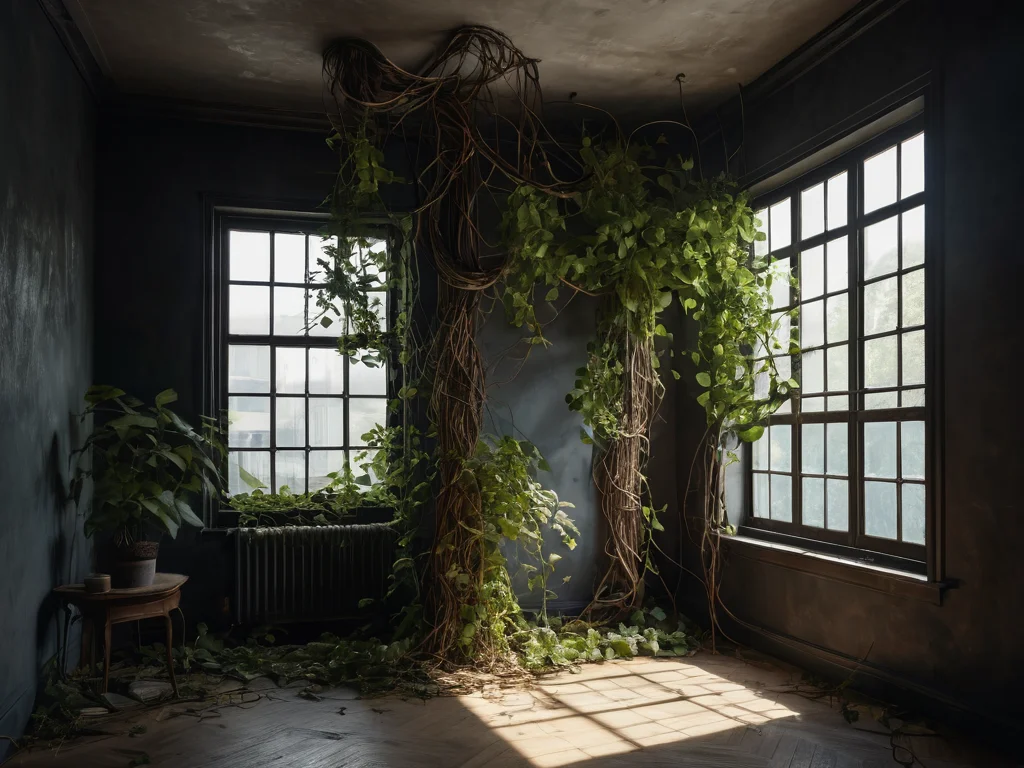
Despite all their obvious advantages, climbing plants can become a source of disharmony in your home if used incorrectly. Mistakes that seem insignificant from an ordinary person’s perspective are serious violations of energetic balance for a Feng Shui master. Let’s look at the 5 most common “hidden threats” so you can avoid them.
- Excess and neglect: This is perhaps the most common and most dangerous mistake. The desire to surround yourself with greenery is commendable, but an excess of climbing plants, especially those that appear chaotic and unkempt, can create a feeling of neglect, disorder, and energetic stagnation. An overloaded space does not allow Qi to circulate freely, which can lead to feelings of oppression, fatigue, apathy, and even health problems. Dried, yellowed, or broken vines are sources of “dead Qi,” which attracts negativity and hinders prosperity. It is always better to have one healthy, well-cared-for plant than ten neglected ones.
- Incorrect placement in critical zones:
- Bedroom: Climbing plants are not recommended in the bedroom, especially if there are many of them. They generate strong Wood (Yang) energy, which can disrupt restful sleep and lead to anxiety. Vines are believed to symbolize “entanglement” in relationships or “entwining” personal life. They also consume oxygen at night, which can worsen air quality for sleep.
- Kitchen: Placing climbing plants in the kitchen is also undesirable. This is a zone of Fire (stove) and Water (sink), and the Wood element (plants) conflicts with these energies. Moreover, cleanliness and the absence of obstacles are important in the kitchen, and overgrown vines can collect dust and grease, becoming a breeding ground for insects, which disrupts the energy of this important zone responsible for nutrition and abundance.
- Bathroom: Although many plants tolerate humidity well in the bathroom, from a Feng Shui perspective, it is not the best place for them. The bathroom is a place where energy drains away, and placing live plants there can symbolize the leakage of life energy and well-being. Furthermore, in dimly lit bathrooms, plants can accumulate Yin energy, which is undesirable.
- Over doorways and passages: Never allow climbing plant vines to hang over doorways, corridors, or other passages. This creates a feeling of “pressure from above,” symbolizing obstacles, difficulties in decision-making, and blocking new opportunities. The flow of Qi will slow down, and people will feel oppressed or even aggressive.
- Over the bed or desk: Similar to passages, hanging vines over the bed can cause anxiety, disrupt sleep, and create a feeling of being overwhelmed. Over a desk, they can hinder clarity of thought, concentration, and block career growth. Always direct the growth upwards or sideways.
- Plants with thorns or prickles: Any climbing plants with thorns, prickles, or very sharp leaves generate aggressive Sha Qi. They can cause conflicts, quarrels, tension, and hinder harmony in the home. They should be avoided in interiors.
- Overly chaotic, unmanaged growth: If you do not direct the vine’s growth, allowing it to twist anywhere, it symbolizes chaos and lack of control in your life. In Feng Shui, such growth can create a sense of disorder, confusion, obstacles, and lack of clarity in goals.
- Using artificial climbing plants: Artificial plants, especially dusty and old ones, do not carry living Qi. They can imitate the form but do not provide Wood energy. Moreover, they collect dust and can create a false sense of freshness, actually attracting stagnant energy. If you want to decorate a space, it is better to choose a healthy live plant than an artificial one.
By avoiding these common mistakes, you can truly unlock the potential of climbing plants and make them powerful allies in creating a harmonious and prosperous home.
Secrets of Prosperity: Caring for Climbing Plants as a Key to Maintaining Harmony
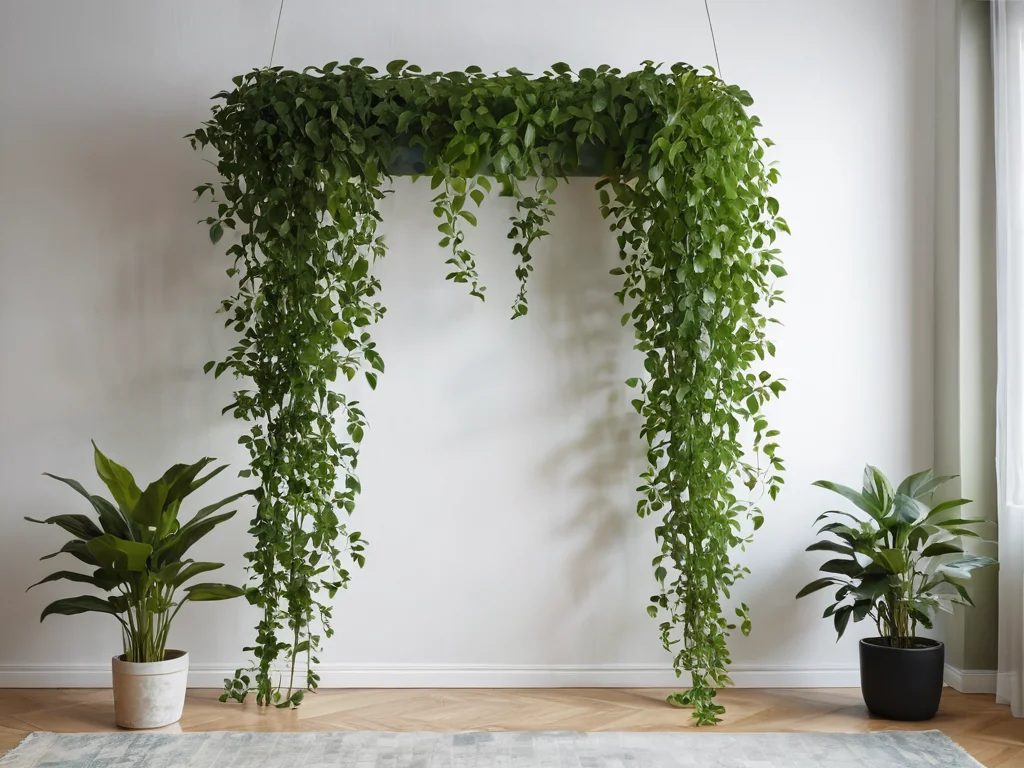
In Feng Shui, plant care is not just routine duties of watering and fertilizing. It is an act of interacting with living energy, symbolizing your attitude towards your own well-being and prosperity. A healthy, lush plant radiates powerful Sheng Qi, while a wilting or sick one, on the contrary, attracts negativity and stagnation. Therefore, proper and conscious care for your climbing plants is the cornerstone of maintaining harmony in the home.
Watering – Life-Giving Moisture for Qi:
- Regularity and moderation: Water plants as needed, avoiding both drying out and overwatering. Soil that is too dry symbolizes the depletion of life forces, while waterlogged soil symbolizes stagnation and rot. Both negatively affect the plant’s Qi and, consequently, the energy of the room.
- Water quality: If possible, use settled water at room temperature. It is believed that this enhances the plant’s vitality and brings cleaner energy into the home.
Fertilizing – Energy for Growth and Development:
- Timely nutrition: Climbing plants, especially fast-growing ones, need regular fertilization during their active growth period. Sufficient nutrition symbolizes abundance and the influx of resources into your life. A lack of nutrients makes the plant weak and stunted, which is reflected in the prosperity energy of the home.
- Natural fertilizers: Preferring natural, organic fertilizers can strengthen the plant’s connection with nature and bring cleaner, natural Qi into the home.
Pruning – Shaping Flows and Renewal:
- Removal of dry and diseased parts: Regularly prune all dry, yellowed, or diseased leaves and stems. This is critically important, as dead plant parts are sources of dead, stagnant Qi, which attracts negative events and illnesses. Pruning symbolizes getting rid of everything old and unnecessary, opening the way for the new and fresh.
- Shaping the crown: As mentioned, direct the plant’s growth by pruning excess or chaotically growing vines. This is not only aesthetically pleasing but also symbolizes your control over your life and your ability to direct energy in the right direction. Maintain a neat and harmonious shape, avoiding excessive overgrowth that creates a sense of chaos.
Leaf Cleanliness – Free Breathing of Qi:
- Wiping off dust: Regularly wipe leaves with a damp cloth. Dust not only hinders the plant’s photosynthesis but also blocks energy exchange with the environment. Clean leaves symbolize clarity, purity of thought, and the free influx of fresh Qi into the home. Dusty leaves represent stagnation, murkiness, and obstacles.
Repotting – Renewal and Expansion of Opportunities:
- Timely renewal: When a plant outgrows its pot, its roots begin to suffer, which symbolizes constrained circumstances and the impossibility of growth and development. Timely repotting into a larger pot with new, fresh soil symbolizes the expansion of your opportunities, new horizons, and the influx of fresh energy for growth.
Energetic Interaction – Connection with Living Nature:
- Positive thoughts and intentions: Talk to your plants, express gratitude and love to them. Plants are believed to be sensitive to emotions. The positive energy you give them returns to you in the form of enhanced Sheng Qi in your home. This creates a deep connection between you and living nature, filling the space with warmth and harmony.
- Attention to health: Regularly inspect plants for pests or diseases. Timely treatment prevents the spread of negative energy and maintains the plant’s vitality.
Remember that caring for climbing plants is not only about taking care of them but also about taking care of yourself, your home, and your life. By dedicating attention and love to them, you invest in your well-being, creating a living source of prosperity.
Your Green Beacon of Well-being: Creating an Energetically Strong Space with Climbing Plants

So, we have taken an exciting journey into the world of climbing plants and their role in the ancient art of Feng Shui. Now you are armed with knowledge that will allow you to turn these green inhabitants into powerful allies on the path to harmony, luck, and well-being in your home.
Climbing plants are not just a decorative element. They are living energy conductors capable of actively shaping the atmosphere of your space. Their Wood energy symbolizes growth, development, and vitality. When you learn to direct their growth, you learn to manage Qi flows, creating zones of prosperity and neutralizing negativity.
Let’s summarize the key principles that will be your guide:
- Conscious choice: Prefer plants with soft, rounded, or heart-shaped leaves, avoiding thorns and prickles. Choose healthy, lush specimens that radiate vitality.
- Strategic placement: Place vines in favorable Bagua zones – Southeast (wealth), East (family, health), South (fame). Use them to soften sharp corners and mask undesirable structures. Avoid placement in the bedroom, kitchen, bathroom, as well as over passages and work areas.
- The art of direction: Always direct plant growth upwards or horizontally along walls, using supports. Symbolically, this signifies striving for development, progress, and success. Regularly prune and shape the crown to avoid chaos and energy stagnation.
- Thorough care: A healthy plant is a source of Sheng Qi. Regular watering, fertilizing, pruning withered parts, and cleaning leaves of dust are not just routine but a ritual of care that enhances positive energy in your home. Your plants are a mirror of your well-being.
- Balance in all things: Do not allow an excess of plants, which can create a feeling of clutter and impede the free flow of Qi. Strive for harmony and moderation.
Imagine your home as a living organism, and climbing plants as its veins and arteries through which life energy flows. When these “vessels” are healthy, clean, and properly directed, the entire organism functions harmoniously, attracting luck and abundance.
Start today. Look at your climbing plants with new eyes. Perhaps they need a new support, a fresh pot, or just a little more of your attention. Let them become your “green beacon of well-being,” illuminating the path to a harmonious and happy life. When you invest your energy in creating a favorable environment for your plants, you invest in your own prosperity. May your home be filled with fresh, living Qi, and may climbing plants become your faithful assistants in this fascinating endeavor!
